Eyelid Surgery
Eyelid Surgery in Carmel, IN
Dr. Barry L. Eppley has years of experience helping patients with wrinkles and bags around the eyes. To view patient results, please visit the eyelid surgery before and after photos page.
THE EYELIDS SHOW THE FIRST SIGNS OF AGING
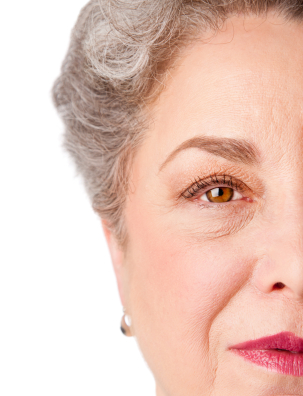 The appearance of the eyes are often viewed as the ‘window to the soul’ of the individual. Their ability to reflect a wide range of emotions adds a great deal to one’s facial expressions. Unfortunately, the eyes and forehead are also the first to show the signs of the aging process. From the development of fine wrinkles and puffiness around the eyes in the thirties and forties to more wrinkles, bags under the eyes, and deep forehead creases by the fifties and sixties, the appearance of being tired and aging around the eyes is unavoidable. Long-term exposure to the sun and smoking also accelerates this process. Botox and other injectable treatments provide superb wrinkle reduction effects of the forehead and around the eyes but are usage to get rid of redundant and loose tissues. Fortunately, a variety of rejuvenating surgical procedures for the eyelids exists today to combat this ubiquitous facial aging concern.
The appearance of the eyes are often viewed as the ‘window to the soul’ of the individual. Their ability to reflect a wide range of emotions adds a great deal to one’s facial expressions. Unfortunately, the eyes and forehead are also the first to show the signs of the aging process. From the development of fine wrinkles and puffiness around the eyes in the thirties and forties to more wrinkles, bags under the eyes, and deep forehead creases by the fifties and sixties, the appearance of being tired and aging around the eyes is unavoidable. Long-term exposure to the sun and smoking also accelerates this process. Botox and other injectable treatments provide superb wrinkle reduction effects of the forehead and around the eyes but are usage to get rid of redundant and loose tissues. Fortunately, a variety of rejuvenating surgical procedures for the eyelids exists today to combat this ubiquitous facial aging concern.
UPPER EYELID LIFT (Upper Blepharoplasty)
The upper eyelid primarily develops an excess amount of skin as one ages. The skin creates an upper eyelid roll and eventual a hooding effect if enough develops to hang down onto one’s eyelashes. The weight of the eyelid may be sufficient enough that it creates upper visual field obstruction.
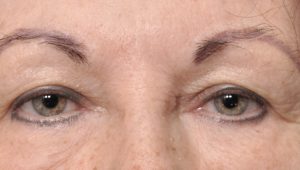
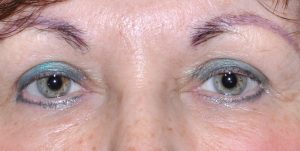 An upper eyelid lift primarily consists of removal of excess skin, placing the final closure along the natural crease of the upper eyelid. Some underlying orbicularis muscle may be removed with the skin but it is not usually necessary to remove much muscle. It is important to extend the skin excision out beyond the corner of the eye to remove any temporal hooding. The amount of skin removed in the upper eyelid can vary based on one’s age and the amount of skin present. While possible to remove too much upper eyelid skin, this is a very rare possibility. Some inner and central upper eyelid fat may also be removed if needed.
An upper eyelid lift primarily consists of removal of excess skin, placing the final closure along the natural crease of the upper eyelid. Some underlying orbicularis muscle may be removed with the skin but it is not usually necessary to remove much muscle. It is important to extend the skin excision out beyond the corner of the eye to remove any temporal hooding. The amount of skin removed in the upper eyelid can vary based on one’s age and the amount of skin present. While possible to remove too much upper eyelid skin, this is a very rare possibility. Some inner and central upper eyelid fat may also be removed if needed.
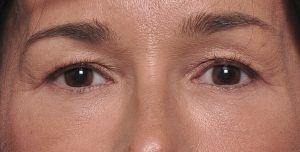
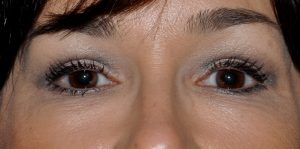 While some perceive that eyelid surgery is for ‘older’ patients, the reality is that excessive upper eyelid skin can appear quite early. If only an isolated ‘smaller’ upper eyelid lift is needed this can be dine under local anesthesia.
While some perceive that eyelid surgery is for ‘older’ patients, the reality is that excessive upper eyelid skin can appear quite early. If only an isolated ‘smaller’ upper eyelid lift is needed this can be dine under local anesthesia.
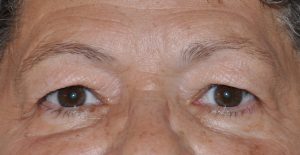
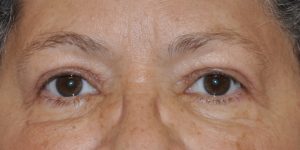 Because a sagging brow can create the appearance of excess skin in the upper eyelid, upper eyelid lifts need to take into consideration the potential need for a browlift as well.
Because a sagging brow can create the appearance of excess skin in the upper eyelid, upper eyelid lifts need to take into consideration the potential need for a browlift as well.
LOWER EYELID LIFT (Lower Blepharoplasty)
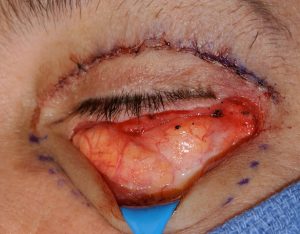 Aging of the lower eyelid not only results in loose and excess skin but it also develops bags (fat herniation), wrinkles and a loose or lax lateral canthal tendon. Thus lower eyelid lifts are very different than that of the upper eyelid and require different anatomic considerations techniques for their correction.
Aging of the lower eyelid not only results in loose and excess skin but it also develops bags (fat herniation), wrinkles and a loose or lax lateral canthal tendon. Thus lower eyelid lifts are very different than that of the upper eyelid and require different anatomic considerations techniques for their correction.
Lower Eyelid Lift (Transcutaneous Approach)
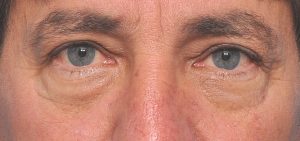
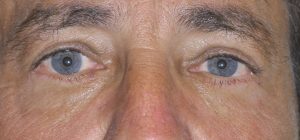
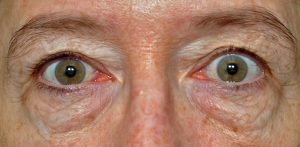
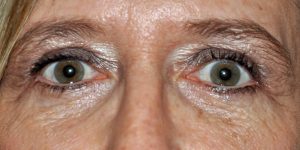 The traditional lower eyelid lift is done by making a skin incision one millimeter below the eyelash line and extending it out into a skin crease from the corner of the eye. A skin-muscle flap is raised, protruding fat is either removed or transposed over the infraorbital rim and the excess skin redraped up over the eye and removed. In some cases, the canthal tendon of the lower eyelid may be tightened (canthopexy) or repositioned (canthoplasty) to tighten a weak lower eyelid support mechanism.
The traditional lower eyelid lift is done by making a skin incision one millimeter below the eyelash line and extending it out into a skin crease from the corner of the eye. A skin-muscle flap is raised, protruding fat is either removed or transposed over the infraorbital rim and the excess skin redraped up over the eye and removed. In some cases, the canthal tendon of the lower eyelid may be tightened (canthopexy) or repositioned (canthoplasty) to tighten a weak lower eyelid support mechanism.
Pinch Lower Eyelid Lift
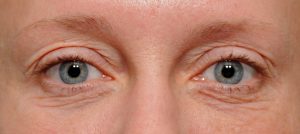
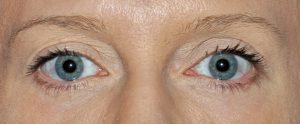 To deal with smaller amounts of loose lower eyelid skin, a more limited form of a transcutaneous lower eyelid lift is done. Under the lash line, skin is pinched up using a special instrument and then removed without undermining the entire lower eyelid skin. This can be combined with chemical peels or laser resurfacing at the same time as the blood supply to the eyelid skin has not been disrupted. (unlike a full transcutaneous lower eyelid lift) This pinch lower eyelid lift is used in younger patients who have early onset eyelid aging or as a touchup or maintenance procedure for those who have already had a prior eyelid lift procedure.
To deal with smaller amounts of loose lower eyelid skin, a more limited form of a transcutaneous lower eyelid lift is done. Under the lash line, skin is pinched up using a special instrument and then removed without undermining the entire lower eyelid skin. This can be combined with chemical peels or laser resurfacing at the same time as the blood supply to the eyelid skin has not been disrupted. (unlike a full transcutaneous lower eyelid lift) This pinch lower eyelid lift is used in younger patients who have early onset eyelid aging or as a touchup or maintenance procedure for those who have already had a prior eyelid lift procedure.
Lower Eyelid Lift – Transconjunctival Blepharoplasty
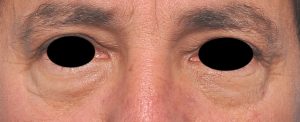
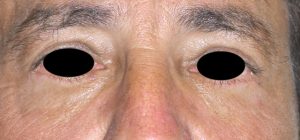
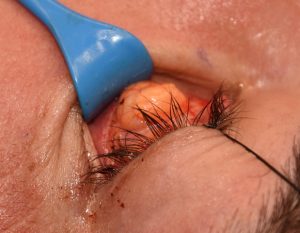 For patients with protruding fat or bags with loose lower eyelid skin, a transconjunctival blepharoplasty can be performed. Through an incision on the inside of the eyelid, the protruding fat is either removed (most common) or moved out to cover the infraorbital rim to correct a tear trough deformity. If needed, a small pinch lower blepharoplasty or a chemical peel/laser resurfacing can be done on the lower eyelid skin.
For patients with protruding fat or bags with loose lower eyelid skin, a transconjunctival blepharoplasty can be performed. Through an incision on the inside of the eyelid, the protruding fat is either removed (most common) or moved out to cover the infraorbital rim to correct a tear trough deformity. If needed, a small pinch lower blepharoplasty or a chemical peel/laser resurfacing can be done on the lower eyelid skin.
Upper and Lower Blepharoplasty (4-Lid Eyelid Lifts)
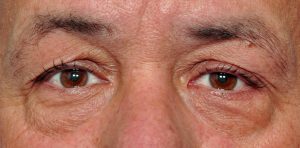
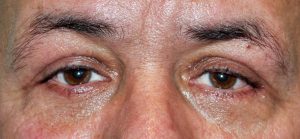 Since all four eyelids age similarly, it is very common to have both upper and lower eyelid lifts done at the same time. This is the most effective approach to a more complete periorbital rejuvenation effect. Many patients come in and only want either upper or lower eyelid lifts done. There is certainly nothing wrong with this approach but one should not overlook all eyelids to avoid additional aging eyelids concerns later.
Since all four eyelids age similarly, it is very common to have both upper and lower eyelid lifts done at the same time. This is the most effective approach to a more complete periorbital rejuvenation effect. Many patients come in and only want either upper or lower eyelid lifts done. There is certainly nothing wrong with this approach but one should not overlook all eyelids to avoid additional aging eyelids concerns later.
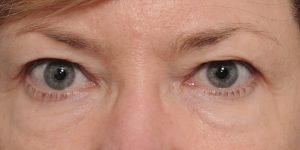
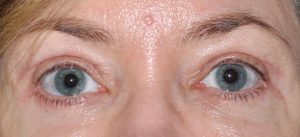 The concerns about an ‘overdone’ look and eyes that may look very unnatural can occur from combined upper and lower blepharoplasties if they are done aggressively. Too much eyelid skin removal can also cause dry eye symptoms from delayed or incomplete closure of the eyelids and slowing of the blink reflex. Judicious tissue removal and experience in managing the delicate tissues of the eyelids can create successful and natural 4-lid blepharoplasty surgery results even when combined with browlift surgery as well..
The concerns about an ‘overdone’ look and eyes that may look very unnatural can occur from combined upper and lower blepharoplasties if they are done aggressively. Too much eyelid skin removal can also cause dry eye symptoms from delayed or incomplete closure of the eyelids and slowing of the blink reflex. Judicious tissue removal and experience in managing the delicate tissues of the eyelids can create successful and natural 4-lid blepharoplasty surgery results even when combined with browlift surgery as well..
Asian Blepharoplasty (Double Eyelid Surgery)
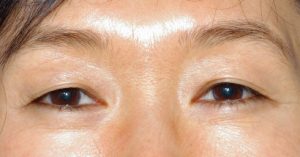
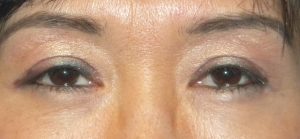
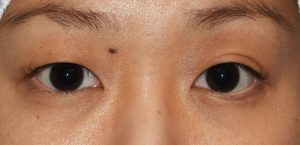
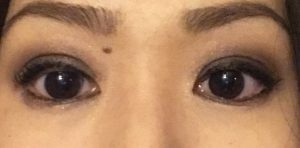 Asian blepharoplasty, usually called double eyelid surgery, is quite different than a Caucasian eyelid lift. It refers to a surgical technique that is designed to create a visible fold (pretarsal crease) in the Asian eye which is absent. This is done not by a lot of skin removal but by a very small amount of skin excision, precisely placed, and sutured down to the deeper structure of the eyelid. It may or may not involve some fat removal as well. This is not an operation that is designed to ‘westernize’ the Asian eyelid appearance which the vast majority of Asian patients do not want to do.
Asian blepharoplasty, usually called double eyelid surgery, is quite different than a Caucasian eyelid lift. It refers to a surgical technique that is designed to create a visible fold (pretarsal crease) in the Asian eye which is absent. This is done not by a lot of skin removal but by a very small amount of skin excision, precisely placed, and sutured down to the deeper structure of the eyelid. It may or may not involve some fat removal as well. This is not an operation that is designed to ‘westernize’ the Asian eyelid appearance which the vast majority of Asian patients do not want to do.
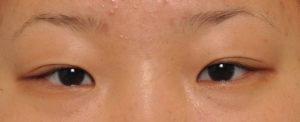
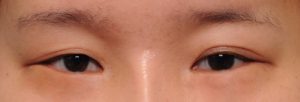 Some Asian patients have some semblance of an upper eyelid crease but it is incomplete. Double eyelid surgery techniques can be used to create a more complete upper eyelid crease as well.
Some Asian patients have some semblance of an upper eyelid crease but it is incomplete. Double eyelid surgery techniques can be used to create a more complete upper eyelid crease as well.
Love Band (Aeygo Sal) Surgery
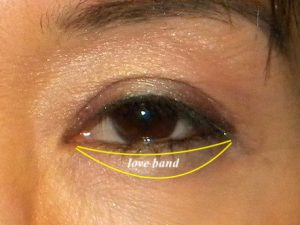 One unique type of lower eyelid surgery, most commonly requested in Asians although not exclusively so, is that of love band or Aeygo Sal surgery. Having a more prominent undereye roll directly beneath the lash line is can be viewed as aesthetically desirable as it is associated with youthfulness. While created by the orbicularis muscle when young this muscle atrophies with age and even some young patients have little to no orbicularis muscle roll at all. This can be created at any age with the placement of a tissue graft right under the lower eyelid lash line, most commonly done using an Alloderm tissue graft. It is placed by a tunneling technique through two very small incisions at either end of the desired roll line. Such Alloderm grafts generally have very good persistence in the relatively adynamic lower eyelid.
One unique type of lower eyelid surgery, most commonly requested in Asians although not exclusively so, is that of love band or Aeygo Sal surgery. Having a more prominent undereye roll directly beneath the lash line is can be viewed as aesthetically desirable as it is associated with youthfulness. While created by the orbicularis muscle when young this muscle atrophies with age and even some young patients have little to no orbicularis muscle roll at all. This can be created at any age with the placement of a tissue graft right under the lower eyelid lash line, most commonly done using an Alloderm tissue graft. It is placed by a tunneling technique through two very small incisions at either end of the desired roll line. Such Alloderm grafts generally have very good persistence in the relatively adynamic lower eyelid.
Before Eyelid Surgery
A thorough examination of the eyes and the tissues surrounding them (eyebrows, forehead, and cheeks) is initially made and photographs taken. The length of the forehead, the amount of eyebrow sagging (ptosis), and the amount of excess skin and fat of the eyelids is recorded and the various surgical options for correction of the problem is discussed. An examination by an ophthalmologist may be recommended, particularly if one has symptoms of loss of the upper visual fields, dryness or itchiness of the eyes, or problems with their vision. This examination must be completed prior to surgery.
The main surgical options to be considered include removal of skin and fat from the upper and/or lower eyelids known as blepharoplasties. Most blepharoplasties of the upper eyelid primarily involve removal of excessive and overhanging skin. Its removal is designed to create a more apparent and youthful sulcus between the lash line and the eyebrows. In some cases upper eyelid fat is removed but this is not a major part of upper blepharoplasty surgery. In contrast, lower blepharoplasties are about managing the protruding fat (herniated lower eyelid fat) as well as the excessive skin. On the lower eyelid, what to do with the fat is just if not more important than that of the skin. Lower eyelid fat can be simply removed or it can be relocated further out over the lower eye socket bone to help fill in deep hollows (fat transposition). Most blepharoplasties are done through an open approach by making incisions, known as a transcutaneous blepharoplasty. In patients with herniated fat and little to no excessive skin of the lower eyelid, the fat may be removed from inside the eyelid with no external skin incision (transconjunctival lower blepharoplasty). There are also the options in younger patients with more minor eyelid aging issues of ‘mini’ blepharoplasties where just small amounts of skin are removed (pinch blepharoplasties) which can safely be combined with skin resurfacing through chemical peels or lasers. Which procedures and combinations are best in any patient requires a thorough discussion of the advantages and disadvantages of each.
Medications that contain aspirin are to be discontinued two weeks prior to surgery to decrease the possibility of excess bleeding during or after surgery.
Cosmetic Procedures – Eyelid Surgery – Operation
The blepharoplasty procedure (removal of skin and fat from the eyelids) is always performed as an outpatient procedure. It is usually done under general anesthesia dependent upon the extent of the surgical procedure. In some case of upper eyelid surgery, it may be capable of being done under local anesthesia. This is not possible for lower eyelid surgery, however, because patients cannot sit still when they have to actually see the surgery. Prior to surgery, markings are made on the eyelids to outline the intended incisions. The incisions are made in the natural lines and creases of the eyelids. In the upper eyelids, there is always a natural skin crease well above the eyelashes that is used. In the lower eyelids, the skin incision is placed right below the line of the eyelashes. In some select patients (those that only require fat removal from the lower eyelid), incisions may only be made from inside the eyelids. During the procedure, excess skin is removed from the eyelids which results in elimination of most of the skin folds around the eyes. Fat is gently teased from underneath the skin and muscle to get rid of the puffiness or fullness of the eyelids. The incisions are then closed with small sutures and only special eye antibiotic ointment is used on the incision lines. This procedure can take from one to two hours depending upon how many eyelids are done.
Lifting of the eyebrows and forehead (brow lift) may be performed in addition to the blepharoplasty procedure if the low position of the eyebrows is contributing to the appearance of too much skin in the upper eyelid and/or creates an angry or tired look to the eye area.
Recovering from Eyelid Surgery
With blepharoplasty surgery, only special eye antibiotic ointment is applied to the suture lines and there are no bandages or other dressings. Considerable eyelid swelling and some bruising around the eyes should be expected which will take several weeks to resolve. This is why icing the eyes right after surgery, keeping the head elevated for the first few days after surgery and taking Arnica oral supplements is so important. Sutures will be removed in five to seven days after surgery. Makeup can be applied one week after surgery. Complete clearing of all swelling and bruising may take up to three weeks to resolve.
Complications associated with eyelid and forehead surgery are few. The most severe complication is sagging of the lower eyelid (ectropion) due to lack inadequate muscle or tendon support or over-resection of skin from the eyelids such that the eyes cannot close completely or an increased tendency after surgery for dryness or itchiness of the eyes. These complications are best avoided by a more conservative approach to eyelid surgery and having patients understand that not every wrinkle or fold of skin will be removed. Otherwise, healing problems with the incisions are quite rare. Subtle differences in position of the eyelids or amount of remaining skin and fat about the eyes may be perceived on close examination.

North Meridian Medical Building
Address:
12188-A North Meridian St.
Suite 310
Carmel, IN 46032
Contact Us:
Phone: (317) 706-4444
WhatsApp: (317) 941-8237
